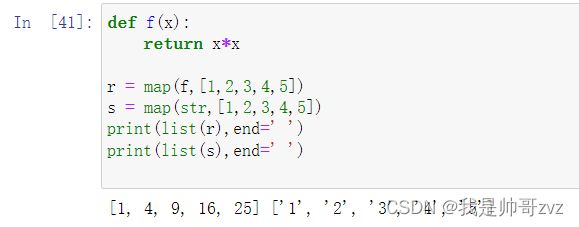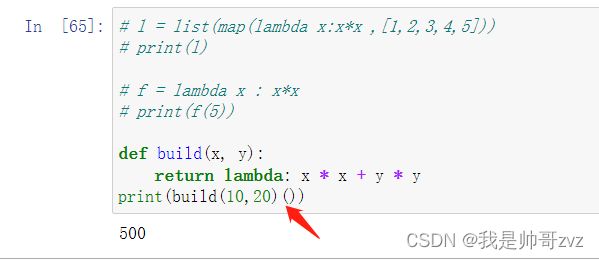【python基础】 函数式编程
本章包含:高阶函数、闭包、匿名函数、装饰器、偏函数
参考:廖雪峰python
函数式编程
- 高阶函数
-
- 高阶函数定义
- map函数
- reduce函数
- filter函数
- sorted函数
- 匿名函数
-
- 作为参数使用
- 匿名函数对象
- 作为函数返回值
- 闭包
-
- 返回函数
- 闭包特点
- 外部函数变量赋值
- 装饰器
-
- 多个装饰器
- 传入参数
- 偏函数
高阶函数
高阶函数定义
map函数
map函数接受两个参数,一个是函数,一个是iterable。
map将传入的函数依次作用到每个iterable元素,然后返回iterator。可使用list转换为列表。
reduce函数
导入库:from functools import reduce
reduce函数接受两个参数,一个是函数,一个是iterable。
这个参数函数必须能接受两个参数,函数作用在每个元素上,每一次的结果和下一个元素做累积计算。
比如生成如下:
filter函数
filter函数接受两个参数,一个函数,一个iterable。
传入的函数作用到每个元素,返回True或False来决定是否丢弃该元素。返回Iterator

生成素数例子:
def odd_iter(): # 奇数生成器
n = 1
while True:
n = n+2
yield n
def not_divisible(n): #如果是2 3 5...倍数,筛选掉
return lambda x: x % n >0
def primes():
yield 2
it = odd_iter() # 初始序列
while True:
n = next(it) # 返回序列的第一个数
yield n
it = filter(not_divisible(n), it) # 构造新序列
for n in primes():
if n < 1000:
print(n)
else:
break
sorted函数
sorted函数传入iterable,其中key和reverse可选参数

匿名函数
作为参数使用
l = list(map(lambda x:x*x,[1,2,3,4]))
print(l)
#[1,4,9,16]
匿名函数对象
f = lambda x: x+1
f(2)
# 3
作为函数返回值
闭包
返回函数
把函数作为返回值的函数叫做返回函数。
下面例子中,lazy_sum的返回值是sum函数,故v是sum函数的引用。再一次使用v()便可得到求和。
def lazy_sum(*args):
def sum():
n = 0
for i in args:
n += i
return n
return sum
v = lazy_sum(1,3,5,6,7) #此时v就是sum的引用
v() #调用sum()
闭包特点
外层函数作用域变量会以某种形式保留下来。
下面例子,先定义两个power,exp值分别为2和3。定义完了之后,其变量就以闭包的形式保留了下来(原本函数结束,作用域也会消失)。
def power(exp):
def exp_of(base):
return base**exp
return exp_of
square = power(2)
cube = power(3)
print(square(2)) #exp_of(2) —— exp =2 被保留
print(square(5))
print(cube(3))
#4
#25
#27
外部函数变量赋值
如果内部函数需要对外部函数变量赋值,则使用nonlocal声明。
def func1():
x = 0
y = 0
def func2(x1,y1):
nonlocal x,y
x += x1
y += y1
print(f'x is {x}, y is {y}')
return func2
f = func1()
f(1,2)
f(3,4)
#x is 1, y is 2
#x is 4, y is 6
装饰器
装饰器就是函数想要增加一些功能,但又不想修改原函数时,会使用的东西。
def dec(func):
def mes():
print('正在调用 {0}'.format(func.__name__))
func()
return mes
@dec
def func2():
print('这是func2')
func2()
#正在调用 func2
#这是func2
上面代码等价于:(可见装饰器是闭包的高阶函数)
def dec(func):
def mes():
print('正在调用 {0}'.format(func.__name__))
func()
return mes
def func2():
print('这是func2')
func2 = dec(func2) # mes()函数
func2()
多个装饰器
def add(func):
def inner():
x = func()
return x+1
return inner
def cube(func):
def inner():
x = func()
return x*x*x
return inner
def square(func):
def inner():
x = func()
return x*x
return inner
@add
@cube
@square
def func():
return 2
print(func())
# 65
#先调用square、cube、add
传入参数
def func1(mes):
def func2(func):
def func3():
print('正在调用 {0}'.format(func.__name__))
func()
print('传入的message是 {0}'.format(mes))
return func3
return func2
@func1('Jeff')
def func():
print('this is func')
@func1('Handsome')
def funcb():
print('this is funcb')
func()
funcb()
#正在调用 func
#this is func
#传入的message是 Jeff
#正在调用 funcb
#this is funcb
#传入的message是 Handsome
偏函数
通过设定参数的默认值,可以降低函数调用的难度。而偏函数也可以做到这一点。
导入库import functools,使用 functools.partial(函数,参数=X)
import functools
a = int('111',base=2)
print(a)
int2 = functools.partial(int,base=2)
b = int2('111')
print(b)
#7
#7



